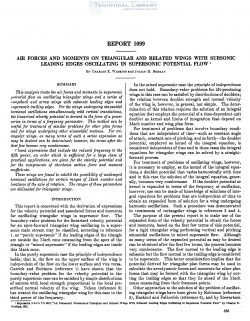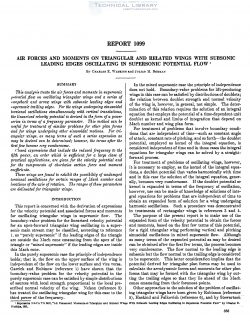naca-report-1099

- Version
- 182 Downloads
- 2.27 MB File Size
- 1 File Count
- September 7, 2016 Create Date
- September 7, 2016 Last Updated
National Advisory Committee for Aeronautics, Report - Air Forces and Moments on Triangular and Related Wings with Subsonic Leading Edges Oscillating in Supersonic Potential Flow

This report is concerned with the derivation of expressions
for the velocity potential and associated forces and moments
for oscillating triangular wings in supersonic flow. The
boundary—value problem for the linearized velocity potential
for an apex-forward triangular wing oscillating in a super-
sonic main stream may be classified, according to reference
1. as “purely supersonic” if the leading edges of the triangle
are outside the Mach cone emanating from the apex of the
triangle or “mixed supersonic” if the leading edges are inside
this Mach cone.
In the purely supersonic case the principle of independence
holds; that is, the flow on the upper surface of the wing is
independent of the flow on the lower surface and vice versa.
Garrick and Rubinow (reference 1) have shown that the
boundary—value problem for the velocity potential in the
purely supersonic case can be satisfied by simple distributions
of sources with local strength proportional to the local pre-
scribed normal velocity of the wing. Nelson (reference 2)
has treated the oscillating triangular wing for this case to the
third power of the frequency.
In the mixed supersonic case the principle of independence
does not hold. Boundary-value problems for lift-producing
Wings in this case can be satisfied by distributions of doublets;
the relation between doublet strength and normal velocity
of the wing is, howover, in general, not simple. The deter-
mination of this relation requires the solution of an integral
equation that employs the potential of a time-dependent unit
doublet as kernel and limits of integration that depend on
Mach number and wing plan form.
For treatment of problems that involve boundary condi-
tions that are independent of time—such as constant angle
of attack, constant rate of pitching, and so forth—the doublet
potential, employed as kernel of the integral equation, is
considered independent of time and in these cases the integral
equations for triangular wings can be solved by a straight-
forward process.
| File | Action |
|---|---|
| naca-report-1099 Air Forces and Moments on Triangular and Related Wings with Subsonic Leading Edges Oscillating in Supersonic Potential Flow.pdf | Download |

Comment On This Post